Nudibranchs (clade Nudibranchia) are soft-bodied marine slugs which have a shell in their larval stage, but lose it as they mature. Many of the species, especially those from the clade Euctenidiacea have an exposed flower-like gills on their back, and hence the name “nudibranchia”, which means “naked gills”. They possess club-shaped rhinophores for detecting odour, and most have oral tentacles to touch and taste.
Many nudibranchs are toxic, deriving the toxins from their prey, such as sponges. To advertise their toxicity, these nudibranchs are usually very brightly coloured. On the other hand, other species may also be dull-coloured so as to avoid predation. Nudibranchs mostly feed on sessile invertebrates such as sponges, hydroids, corals and sea anemones, though some feed on motile animals such as crustaceans or other molluscs. Like other sea slugs, they are hermaphrodites with both male and female reproductive organs. To mate, they usually get into a "69" position side by side and fertilise each other. The reproductive organs are located behind the head on the right side.
There are two main groups of nudibranch - from the clade Euctenidiacea and the clade Dexiarchia. The former include the nudibranchs with the exposed gills on their back and their close relatives, while the latter include the ones with cerata (finger-like structures) on their back and their close relatives.
Clade Euctenidiacea
The Euctenidiacea nudibranchs mostly feed on sponges, except some species that feed on other animals. Many species are poisonous, and are able to secrete chemicals that either make them distasteful or toxic. It is believed that they got the chemicals from the sponges that they feed on. Here are some of the Euctenidiacea nudibranchs that I have seen in Singapore.
Family Discodorididae
Members from the family Discodorididae are able to retract its gills into a gill pocket. Many species are able to break off part of their mantle to distract predators. They generally have a narrow foot compared to the wide mantle skirt.

The Funeral Nudibranch (Jorunna funebris) got its name from the black and white coloration. This is possibly the most commonly seen nudibranch in Singapore. It feeds on a blue sponge (Neopetrosia sp.), and its egg ribbons are white in colour.

Several nudibranchs from the family Discodorididae are able to break off part of their mantle when disturbed, and this is most evident in the Fragile Nudibranch (Sebadoris fragilis). This species was previously confused with Tayuva lilacina and Sebadoris nubilosa, until Dayrat did a phylogenetic study on the family, and kindly identified this species we have in Singapore as Sebadoris fragilis when he was here a few years ago.

The Bohol's Nudibranch (Discodoris boholiensis) is another commonly seen nudibranch, also from the same family Discodorididae. It can break off part of its mantle when threatened as well. This nudibranch is named after the Bohol Islands in the Philippines, and is sometimes mistaken for a flatworm due to its flat body.
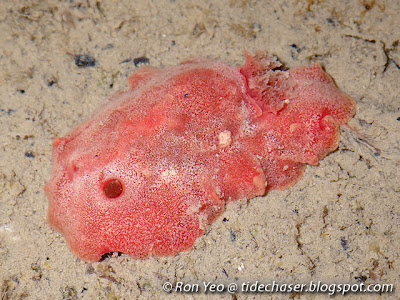
The above is probably a Crawford's Nudibranch (Discodoris crawfordi). It has a sandpaper-like skin, and is usually pinkish to reddish in colour.

From the same family is this huge nudibranch, Asteronotus cespitosus, which is certainly one of the biggest nudibranchs found in Singapore, growing to more than 20cm long. The foot is yellowish in colour.

The Spongy Nudibranch (Atagema spongiosa) really looks like a sea sponge, and blends in very well with its surrounding when it is among sponges. I have seen it with parts of its mantle missing before as well, possibly broken off when it was disturbed by predators.

Atagema intecta has a bumpy appearance and often with a ridge running down the middle of its back. It can break off part of its mantle voluntarily (autotomise) when threatened too.

Platydoris scabra is sometimes seen on our shores, and has a stiff body. It can break off part of its mantle, like most of the other members of its family.

Hoplodoris nodulosa is occasionally seen on our shores, and it has lots of bead-like structures on its back.

Thordisa villosa has a yellow foot on its underside, and lots of tiny bumps on its back.

There are two species of Actinocyclus, both rather similar in appearance, and hence I am not too sure which species this is. It has olive-green egg ribbons.
Family Chromodorididae
Moving on to the family Chromodorididae, slugs from this family are usually colouful, feed on sponges, and are able to retract their gills into a gill pocket.
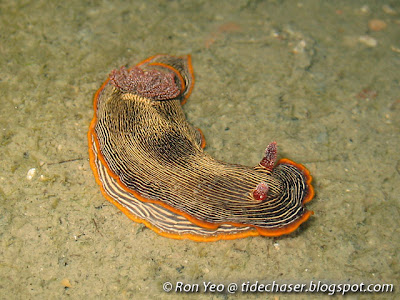
Chromodoris lineolata is regularly seen on our shores, and usually several of them will be seen at the same spot.

So far I have only seen this Chromodoris fidelis while diving.

Chromodoris tumulifera can be easily recognised by the numerous purple blotches on its back.

The Black Margined Nudibranch (Glossodoris atromarginata) is rather commonly seen in Singapore, and often several can be seen during an intertidal exploration. It can exude a milky secretion when disturbed, possibly composed of chemicals to deter predation.

There are several species of Hypselodoris which appear very similar with yellow and blue spots, and there were debates on whether they could be variations of the same species, or really different species. A DNA study is probably required to solve this mystery.

Hypselodoris maritima can be recognised by the black spots on the back, with a broken yellow line and numerous small bluish spots at the edge of the mantle.
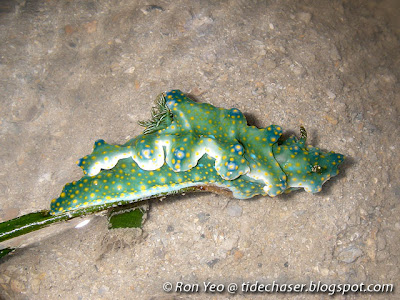
This was previously identified as Ceratosoma sinuatum, but in recent years there were discussions that this is possibly an undescribed Ceratosoma species instead, as the patterns on C. sinuatum should be bigger yellow patches with a network of greenish/purplish outlines.

Ceratosoma gracillimum is seldom seen in the intertidal area, but more often seen while diving in Singapore.
Family Dendrodorididae
Dendrodoridids also feed on sponges, but members of this family do not have a radula, and hence feed by secreting digestive juices on the sponge to partially digest the tissue before sucking up the meal. They are able to retract their gills as well.

The Denison's Nudibranch (Dendrodoris denisoni) is also often seen on our shores. It has several blue spots on its body.
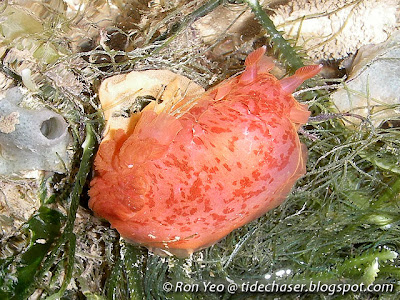
Dendrodoris fumata is often in a pretty reddish colour and lay yellow egg ribbons.
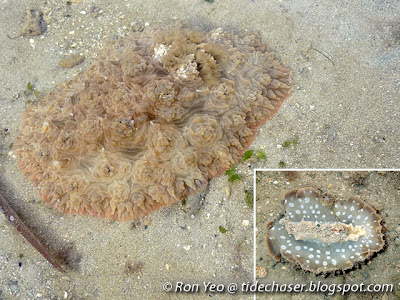
Dendrodoris tuberculosa is another of the bigger nudibranchs we have in Singapore, growing to more than 15cm long. It has numerous white spots on the underside of its foot.
Family Phyllidiidae
Closely related to the Dendrodoris are those from the family Phyllidiidae. Nudibranchs from this family lacks the flower-like dorsal gills. Instead they have a series of simple gills along the underside of the mantle. Like the Dendrodoris, they also lack a radula and feed by secreting digestive juices on the sponge to partially digest the tissue before sucking up the meal. Phyllids are known to secrete toxic chemicals that can kill other small animals in the surrounding when they are stressed.

The Varicose Phyllid Nudibranch (Phyllidia varicosa) is occasionally seen in the intertidal areas of Singapore. The ones we have here have light blue ridges with yellow tips.

The Ocellated Phyllid Nudibranch (Phyllidia ocellata) is rarely seen in the intertidal area, and more often seen in deeper waters. This species has several variations in the region, but so far the ones seen in Singapore has an orange body, white bumps (papillae) and a few black rings.

The Elegant Phyllid Nudibranch (Phyllidia elegans) is another nudibranch seldom seen in the intertidal areas. The papillae on its back have lots of smaller bumps on them, and some of the bigger papillae come with yellow tips.

The Black Phyllid Nudibranch (Phyllidiella nigra) is one of the most commonly seen nudibranchs in Singapore. It has purple papillae.

The Pustulose Phyllid Nudibranch (Phyllidiella pustulosa) is also commonly seen, and sometimes several can be found at the same spot. The word "pustulose" refers to the bumpy outgrowths on the back of this slug, which may be whitish or greenish.
Family Gymnodorididae

A few nudibranchs from the family Gymnodorididae can be seen in Singapore, though they are often not easy to identify. The above, Gymnodoris rubropapulosa, is one of the more easily recognised one with its prominent and slightly protruding orange spots. This nudibranch feeds on other slugs! It also lacks the mantle skirt found in most other Euctenidiacea nudibranchs.
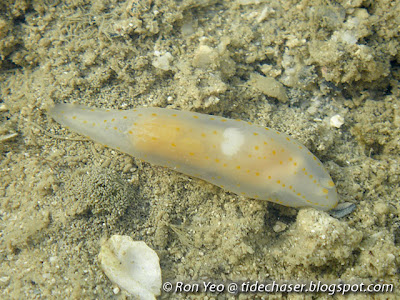
The above is one of the several spotted Gymnodoris spp. which I am still not confident of identifying accurately.

The above is likely to be Gymnodoris inornata, which is all orange.
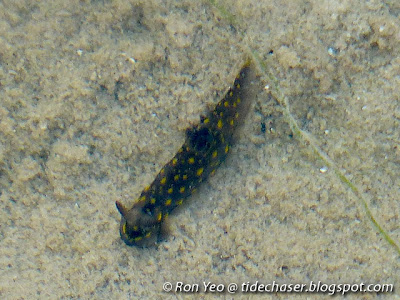
The above is a blackish Gymnodoris sp. with yellow spots, which is yet to be identified.
Clade Dexiarchia
The Dexiarchia nudibranchs come in various forms - some possess lots of thin cerata, others may have bigger cerata, and some may not have any protruding features on their back at all. They feed on a variety of food, including cnidarians, cruastaceans and other animals. Here are some of the Dexiarchia nudibranchs that I have seen in Singapore.
Family Facelinidae
Nudibranchs from this family generally have rows of finger-like cerata on their backs. They feed on hydroids or soft corals, and most species are able to retain the symbiotic algae of their prey in their body.

The Blue Dragon (Pteraeolidia ianthina) is commonly encountered on our shores. It feeds on hydroids, and amazingly, retains the stinging cells (nematocysts) of those hydroids, and fires them for defense when threatened. Also, it retains the symbiotic algae (zooxanthellae) of the hydroid, and the algae continue to photosynthesize and provide food for the slug.

From the same family, Phyllodesmium magnum feed on Sinularia soft coral instead, and retains the zooxanthellae for photosynthesis as well. But instead of retaining any stinging cells, it avoids predation by camouflaging extremely well with the corals that it feeds on. It can also break off some of its cerata, which will wriggle about and produces a sticky secretion which supposedly repels fish.

Similarly, Phyllodesmium briareum retains the zooxanthellae from the soft corals (from the family Briareidae) that it feeds on, and like other Phyllodesmium species, it can voluntarily cast off cerata.

Related to the previous species is Phyllodesmium serratum, which unlike the rest does not form the symbiotic relationship with the zooxanthellae. It feeds on a variety of soft corals, and is highly variable as its colour depends on what it feeds on. It can be recognised by the white median line on its back though.

Cratena lineata also belongs to this family, and it feeds on hydroids too. It can be identified by the white stripes running along its body and cerata (usually reddish) and brownish rhinophores. It usually has two orange patches on each side of its head.
Family Aeolidiidae
Members of this family also have rows of cerata on their backs. Many species are burrowers, and feed on sea anemones or other cnidarians in the sand.

Cerberilla asamusiensis, from the family Aeolidiidae, is a burrower and hence more commonly found on sandy substrates. It is believed to feed on sea anemones.

Cerberilla ambonensis is another aeolidid which burrows. Like other Cerberilla species, it is believed to feed on sea anemones. Most nudibranchs from this genus are seldom seen, since they burrow most of the time.
Family Tergipedidae

Trinchesia sibogae, from the family Tergipedidae, was previously placed under the genus Cuthona. There have been some debates on whether this species should be reverted back to the old genus, but no studies has been done so far to support that. It feeds on hydroids.

I have seen this nudibranch at least twice, but still did not manage to identify it. I suspect it's a Phidiana sp., and the closest will be Phidiana militaris. However, it lacks the white stripe on the cerata found on the latter, and also, the latter usually has a single orange line on its head, not a double line as seen here. Not sure if this is just a variation.

This pretty nudibranch was seen once on Beting Bronok. Hopefully someone who visits my blog can help to identify it?
Family Bornellidae
Slugs from this family generally have thick branching cerata. They generally feed on hydroids.

A few species of nudibranchs from the family Bornellidae can be found in local waters, but I only managed to photograph this one, Bornella stellifer. "Stellifer" means "star-like", refering to the star-like oral tentacles of this species. The cerata has a branching appearance, each with a cluster of gills near the tip. It feeds on hydroids, but does not retain the stinging cells of its prey. It can swim by vigorously bending and swinging its body.
Family Tethydidae
Members of this family also has thick branching cerata. Many species lack a radula, but has an oral veil for catching their prey. Most species can swim by vigorously flexing their bodies.
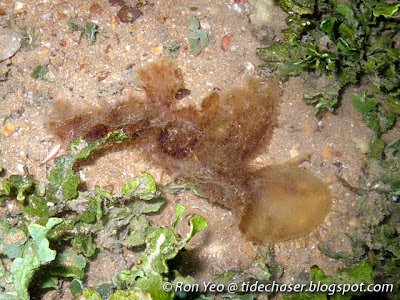
This nudibranch, Melibe viridis, certainly does not look like a slug. Instead of a radula, it has an oral veil with lots of sensory structures at the edge to detect its prey, which are usually small crustaceans. It will then contract the veil to trap and ingest the prey. It can also swim by vigorously flexing its body.
Family Scyllaeidae
Members of this family usually have a few pairs of large lobes running along the sides of their body. Most feed on hyroids.

I have seen two nudibranchs from the family Scyllaeidae so far. The above is a Notobryon sp. which I am still not sure of the exact species as there are a number of similar-looking species. The gills of this species I saw are fairly large (relative to the body) with very extensive branching. It feeds on hydroids, and can swim by flexing its body vigorously.

The exact identity of this Crosslandia sp. is also a mystery to me, as once again, there are a few similar-looking species. This one was found with the seaweed, sargassum, though. It is believed that they feed on small hydroids living on seaweeds. It can swim by flexing its body too.
Family Arminidae
A few nudibranchs from the family Arminidae can also be found in Singapore. These slugs generally lack the cerata or external gills found on the back of many nudibranch species. They have a wide oral veil, possibly for detecting their prey such as sea pen and soft corals.

The above is Armina babai, which is greyish in colour without any patterns on its back. It can burrow very quickly into the soft substrate it lives on.

The Semper's Nudibranch (Armina semperi), on the other hand, has black and white stripes on its back, and a blue foot with a yellow-orange border. This species feeds on sea pen, and they can burrow very well too.

Several similar-looking Dermatobranchus species have been seen in local waters. The one above is the only one which I am rather sure of the exact species - Dermatobranchus albus. The back of this species has white ridges (usually bearing a median yellow line), while the "valleys" are light grey or yellow. Dermatobranchus are known to feed on octocorals.

This is probably a Dermatobranchus fortunata, which I have only seen once at Sentosa.
References
Many nudibranchs are toxic, deriving the toxins from their prey, such as sponges. To advertise their toxicity, these nudibranchs are usually very brightly coloured. On the other hand, other species may also be dull-coloured so as to avoid predation. Nudibranchs mostly feed on sessile invertebrates such as sponges, hydroids, corals and sea anemones, though some feed on motile animals such as crustaceans or other molluscs. Like other sea slugs, they are hermaphrodites with both male and female reproductive organs. To mate, they usually get into a "69" position side by side and fertilise each other. The reproductive organs are located behind the head on the right side.
There are two main groups of nudibranch - from the clade Euctenidiacea and the clade Dexiarchia. The former include the nudibranchs with the exposed gills on their back and their close relatives, while the latter include the ones with cerata (finger-like structures) on their back and their close relatives.
Clade Euctenidiacea
The Euctenidiacea nudibranchs mostly feed on sponges, except some species that feed on other animals. Many species are poisonous, and are able to secrete chemicals that either make them distasteful or toxic. It is believed that they got the chemicals from the sponges that they feed on. Here are some of the Euctenidiacea nudibranchs that I have seen in Singapore.
Family Discodorididae
Members from the family Discodorididae are able to retract its gills into a gill pocket. Many species are able to break off part of their mantle to distract predators. They generally have a narrow foot compared to the wide mantle skirt.

The Funeral Nudibranch (Jorunna funebris) got its name from the black and white coloration. This is possibly the most commonly seen nudibranch in Singapore. It feeds on a blue sponge (Neopetrosia sp.), and its egg ribbons are white in colour.

Several nudibranchs from the family Discodorididae are able to break off part of their mantle when disturbed, and this is most evident in the Fragile Nudibranch (Sebadoris fragilis). This species was previously confused with Tayuva lilacina and Sebadoris nubilosa, until Dayrat did a phylogenetic study on the family, and kindly identified this species we have in Singapore as Sebadoris fragilis when he was here a few years ago.

The Bohol's Nudibranch (Discodoris boholiensis) is another commonly seen nudibranch, also from the same family Discodorididae. It can break off part of its mantle when threatened as well. This nudibranch is named after the Bohol Islands in the Philippines, and is sometimes mistaken for a flatworm due to its flat body.

The above is probably a Crawford's Nudibranch (Discodoris crawfordi). It has a sandpaper-like skin, and is usually pinkish to reddish in colour.

From the same family is this huge nudibranch, Asteronotus cespitosus, which is certainly one of the biggest nudibranchs found in Singapore, growing to more than 20cm long. The foot is yellowish in colour.

The Spongy Nudibranch (Atagema spongiosa) really looks like a sea sponge, and blends in very well with its surrounding when it is among sponges. I have seen it with parts of its mantle missing before as well, possibly broken off when it was disturbed by predators.

Atagema intecta has a bumpy appearance and often with a ridge running down the middle of its back. It can break off part of its mantle voluntarily (autotomise) when threatened too.

Platydoris scabra is sometimes seen on our shores, and has a stiff body. It can break off part of its mantle, like most of the other members of its family.

Hoplodoris nodulosa is occasionally seen on our shores, and it has lots of bead-like structures on its back.

Thordisa villosa has a yellow foot on its underside, and lots of tiny bumps on its back.

There are two species of Actinocyclus, both rather similar in appearance, and hence I am not too sure which species this is. It has olive-green egg ribbons.
Family Chromodorididae
Moving on to the family Chromodorididae, slugs from this family are usually colouful, feed on sponges, and are able to retract their gills into a gill pocket.

Chromodoris lineolata is regularly seen on our shores, and usually several of them will be seen at the same spot.

So far I have only seen this Chromodoris fidelis while diving.

Chromodoris tumulifera can be easily recognised by the numerous purple blotches on its back.

The Black Margined Nudibranch (Glossodoris atromarginata) is rather commonly seen in Singapore, and often several can be seen during an intertidal exploration. It can exude a milky secretion when disturbed, possibly composed of chemicals to deter predation.

There are several species of Hypselodoris which appear very similar with yellow and blue spots, and there were debates on whether they could be variations of the same species, or really different species. A DNA study is probably required to solve this mystery.

Hypselodoris maritima can be recognised by the black spots on the back, with a broken yellow line and numerous small bluish spots at the edge of the mantle.

This was previously identified as Ceratosoma sinuatum, but in recent years there were discussions that this is possibly an undescribed Ceratosoma species instead, as the patterns on C. sinuatum should be bigger yellow patches with a network of greenish/purplish outlines.

Ceratosoma gracillimum is seldom seen in the intertidal area, but more often seen while diving in Singapore.
Family Dendrodorididae
Dendrodoridids also feed on sponges, but members of this family do not have a radula, and hence feed by secreting digestive juices on the sponge to partially digest the tissue before sucking up the meal. They are able to retract their gills as well.

The Denison's Nudibranch (Dendrodoris denisoni) is also often seen on our shores. It has several blue spots on its body.

Dendrodoris fumata is often in a pretty reddish colour and lay yellow egg ribbons.

Dendrodoris tuberculosa is another of the bigger nudibranchs we have in Singapore, growing to more than 15cm long. It has numerous white spots on the underside of its foot.
Family Phyllidiidae
Closely related to the Dendrodoris are those from the family Phyllidiidae. Nudibranchs from this family lacks the flower-like dorsal gills. Instead they have a series of simple gills along the underside of the mantle. Like the Dendrodoris, they also lack a radula and feed by secreting digestive juices on the sponge to partially digest the tissue before sucking up the meal. Phyllids are known to secrete toxic chemicals that can kill other small animals in the surrounding when they are stressed.

The Varicose Phyllid Nudibranch (Phyllidia varicosa) is occasionally seen in the intertidal areas of Singapore. The ones we have here have light blue ridges with yellow tips.

The Ocellated Phyllid Nudibranch (Phyllidia ocellata) is rarely seen in the intertidal area, and more often seen in deeper waters. This species has several variations in the region, but so far the ones seen in Singapore has an orange body, white bumps (papillae) and a few black rings.

The Elegant Phyllid Nudibranch (Phyllidia elegans) is another nudibranch seldom seen in the intertidal areas. The papillae on its back have lots of smaller bumps on them, and some of the bigger papillae come with yellow tips.

The Black Phyllid Nudibranch (Phyllidiella nigra) is one of the most commonly seen nudibranchs in Singapore. It has purple papillae.

The Pustulose Phyllid Nudibranch (Phyllidiella pustulosa) is also commonly seen, and sometimes several can be found at the same spot. The word "pustulose" refers to the bumpy outgrowths on the back of this slug, which may be whitish or greenish.
Family Gymnodorididae

A few nudibranchs from the family Gymnodorididae can be seen in Singapore, though they are often not easy to identify. The above, Gymnodoris rubropapulosa, is one of the more easily recognised one with its prominent and slightly protruding orange spots. This nudibranch feeds on other slugs! It also lacks the mantle skirt found in most other Euctenidiacea nudibranchs.

The above is one of the several spotted Gymnodoris spp. which I am still not confident of identifying accurately.

The above is likely to be Gymnodoris inornata, which is all orange.

The above is a blackish Gymnodoris sp. with yellow spots, which is yet to be identified.
Clade Dexiarchia
The Dexiarchia nudibranchs come in various forms - some possess lots of thin cerata, others may have bigger cerata, and some may not have any protruding features on their back at all. They feed on a variety of food, including cnidarians, cruastaceans and other animals. Here are some of the Dexiarchia nudibranchs that I have seen in Singapore.
Family Facelinidae
Nudibranchs from this family generally have rows of finger-like cerata on their backs. They feed on hydroids or soft corals, and most species are able to retain the symbiotic algae of their prey in their body.

The Blue Dragon (Pteraeolidia ianthina) is commonly encountered on our shores. It feeds on hydroids, and amazingly, retains the stinging cells (nematocysts) of those hydroids, and fires them for defense when threatened. Also, it retains the symbiotic algae (zooxanthellae) of the hydroid, and the algae continue to photosynthesize and provide food for the slug.

From the same family, Phyllodesmium magnum feed on Sinularia soft coral instead, and retains the zooxanthellae for photosynthesis as well. But instead of retaining any stinging cells, it avoids predation by camouflaging extremely well with the corals that it feeds on. It can also break off some of its cerata, which will wriggle about and produces a sticky secretion which supposedly repels fish.

Similarly, Phyllodesmium briareum retains the zooxanthellae from the soft corals (from the family Briareidae) that it feeds on, and like other Phyllodesmium species, it can voluntarily cast off cerata.

Related to the previous species is Phyllodesmium serratum, which unlike the rest does not form the symbiotic relationship with the zooxanthellae. It feeds on a variety of soft corals, and is highly variable as its colour depends on what it feeds on. It can be recognised by the white median line on its back though.

Cratena lineata also belongs to this family, and it feeds on hydroids too. It can be identified by the white stripes running along its body and cerata (usually reddish) and brownish rhinophores. It usually has two orange patches on each side of its head.
Family Aeolidiidae
Members of this family also have rows of cerata on their backs. Many species are burrowers, and feed on sea anemones or other cnidarians in the sand.

Cerberilla asamusiensis, from the family Aeolidiidae, is a burrower and hence more commonly found on sandy substrates. It is believed to feed on sea anemones.

Cerberilla ambonensis is another aeolidid which burrows. Like other Cerberilla species, it is believed to feed on sea anemones. Most nudibranchs from this genus are seldom seen, since they burrow most of the time.
Family Tergipedidae

Trinchesia sibogae, from the family Tergipedidae, was previously placed under the genus Cuthona. There have been some debates on whether this species should be reverted back to the old genus, but no studies has been done so far to support that. It feeds on hydroids.

I have seen this nudibranch at least twice, but still did not manage to identify it. I suspect it's a Phidiana sp., and the closest will be Phidiana militaris. However, it lacks the white stripe on the cerata found on the latter, and also, the latter usually has a single orange line on its head, not a double line as seen here. Not sure if this is just a variation.

This pretty nudibranch was seen once on Beting Bronok. Hopefully someone who visits my blog can help to identify it?
Family Bornellidae
Slugs from this family generally have thick branching cerata. They generally feed on hydroids.

A few species of nudibranchs from the family Bornellidae can be found in local waters, but I only managed to photograph this one, Bornella stellifer. "Stellifer" means "star-like", refering to the star-like oral tentacles of this species. The cerata has a branching appearance, each with a cluster of gills near the tip. It feeds on hydroids, but does not retain the stinging cells of its prey. It can swim by vigorously bending and swinging its body.
Family Tethydidae
Members of this family also has thick branching cerata. Many species lack a radula, but has an oral veil for catching their prey. Most species can swim by vigorously flexing their bodies.

This nudibranch, Melibe viridis, certainly does not look like a slug. Instead of a radula, it has an oral veil with lots of sensory structures at the edge to detect its prey, which are usually small crustaceans. It will then contract the veil to trap and ingest the prey. It can also swim by vigorously flexing its body.
Family Scyllaeidae
Members of this family usually have a few pairs of large lobes running along the sides of their body. Most feed on hyroids.

I have seen two nudibranchs from the family Scyllaeidae so far. The above is a Notobryon sp. which I am still not sure of the exact species as there are a number of similar-looking species. The gills of this species I saw are fairly large (relative to the body) with very extensive branching. It feeds on hydroids, and can swim by flexing its body vigorously.

The exact identity of this Crosslandia sp. is also a mystery to me, as once again, there are a few similar-looking species. This one was found with the seaweed, sargassum, though. It is believed that they feed on small hydroids living on seaweeds. It can swim by flexing its body too.
Family Arminidae
A few nudibranchs from the family Arminidae can also be found in Singapore. These slugs generally lack the cerata or external gills found on the back of many nudibranch species. They have a wide oral veil, possibly for detecting their prey such as sea pen and soft corals.

The above is Armina babai, which is greyish in colour without any patterns on its back. It can burrow very quickly into the soft substrate it lives on.

The Semper's Nudibranch (Armina semperi), on the other hand, has black and white stripes on its back, and a blue foot with a yellow-orange border. This species feeds on sea pen, and they can burrow very well too.

Several similar-looking Dermatobranchus species have been seen in local waters. The one above is the only one which I am rather sure of the exact species - Dermatobranchus albus. The back of this species has white ridges (usually bearing a median yellow line), while the "valleys" are light grey or yellow. Dermatobranchus are known to feed on octocorals.

This is probably a Dermatobranchus fortunata, which I have only seen once at Sentosa.
References
- Dayrat, B. 2010. A Monographic Revision of Basal Discodorid Sea Slugs (Mollusca: Gastropoda: Nudibranchia: Doridina). Proceedings of the California Academy of Sciences, Series 4, Volume 6, Supplement 1: 1–403.
- Debelius, H. & R. H Kuiter. 2007. Nudibranchs of the world. IKAN-Unterwasserarchiv, Frankfurt. 360 pp.
- Gosliner, T. M., D. W. Behrens & Á. Valdés 2008. Indo-Pacific nudibranchs and sea slugs: a field guide to the World’s most diverse fauna. Sea Challengers/California Academy of Sciences: Gig Harbor/San Francisco, 426 pp.
- Ng, P. K. L. & N. Sivasothi (eds.), 1999. A guide to the mangroves of Singapore II: Animal diversity. Singapore Science Centre, 168p.
- Rudman, W. B. 2012. Sea Slug Forum. Retrieved May 10, 2012, from http://www.seaslugforum.net
- Sachidhanandam, U., R. C. Willan & L. M. Chou, 2000. Checklist of the nudibranchs (Opisthobranchia: Nudibranchia) of the South China Sea. Raffles Bulletin of Zoology, Supplement 8: 495–513.
- Tan, S. K. & H. P. M. Woo, 2010. A preliminary checklist of the molluscs of Singapore. Raffles Museum of Biodiversity Research, National University of Singapore, Singapore. 78 pp. Uploaded 02 June 2010.
- Tan, S. K. & R. K. H. Yeo, 2010. The intertidal molluscs of Pulau Semakau: preliminary results of “Project Semakau”. Nature in Singapore, 3: 287–296.

No comments:
Post a Comment